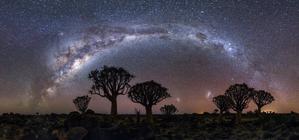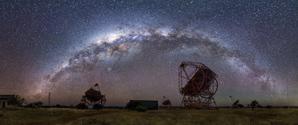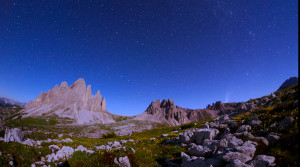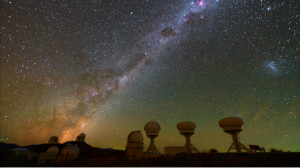Glossary term: Sky
Description: The sky is what we see when we are outside, our view unencumbered by any structure on Earth, looking up or at least higher than the horizon that marks the boundary of what we can see of Earth and earthbound structures. When looking at a clear sky at night, we can see distant planets, stars, and even a few galaxies (the Andromeda galaxy in the northern and the Magellanic Clouds in the southern hemisphere). The twinkling of the stars is evidence that we are still looking through the gases of Earth's atmosphere. During the day, sunlight scattered by air molecules makes the sky shine with a blue color, blocking our view into the cosmos. Clouds or fog covering the sky will also keep us from observing any astronomical objects.
Related Terms:
See this term in other languages
Term and definition status: This term and its definition have been approved by a research astronomer and a teacher
The OAE Multilingual Glossary is a project of the IAU Office of Astronomy for Education (OAE) in collaboration with the IAU Office of Astronomy Outreach (OAO). The terms and definitions were chosen, written and reviewed by a collective effort from the OAE, the OAE Centers and Nodes, the OAE National Astronomy Education Coordinators (NAECs) and other volunteers. You can find a full list of credits here. All glossary terms and their definitions are released under a Creative Commons CC BY-4.0 license and should be credited to "IAU OAE".
Related Media
Milky Way Over Quiver Tree
Credit: Jianfeng Dai/IAU OAE (CC BY 4.0)
License: CC-BY-4.0 Creative Commons Attribution 4.0 International (CC BY 4.0) icons
Milky Way Over H.E.S.S Observatory
Credit: Jianfeng Dai/IAU OAE (CC BY 4.0)
License: CC-BY-4.0 Creative Commons Attribution 4.0 International (CC BY 4.0) icons
Big Dipper and Comet Neowise C2020 F3
Credit: Giorgia Hofer/IAU OAE (CC BY 4.0)
License: CC-BY-4.0 Creative Commons Attribution 4.0 International (CC BY 4.0) icons
Southern Sky Over La Silla
Credit: José Rodrigues/IAU OAE (CC BY 4.0)
License: CC-BY-4.0 Creative Commons Attribution 4.0 International (CC BY 4.0) icons












